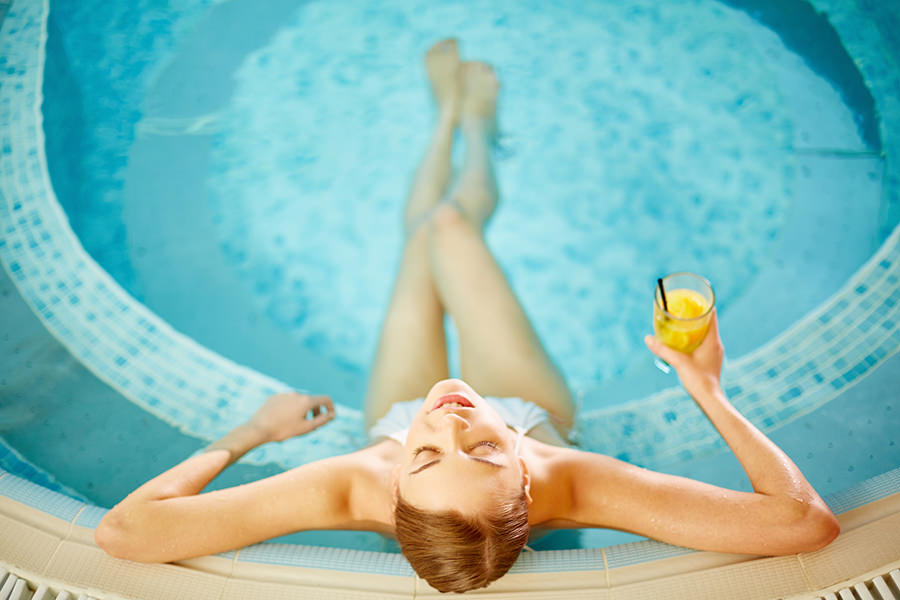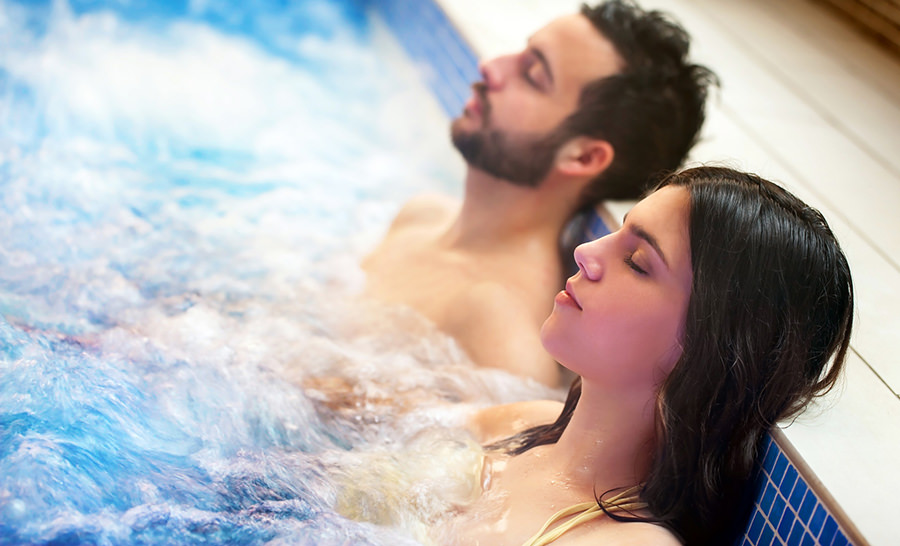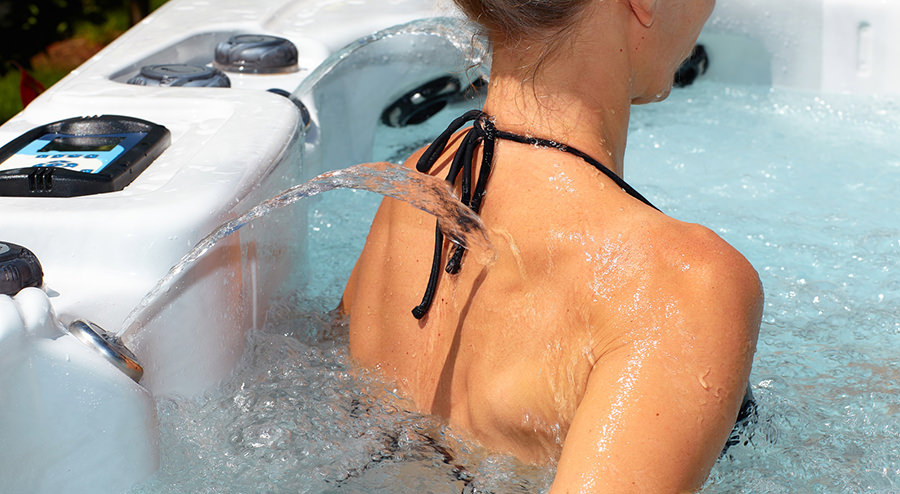
If you have spent any time researching hot tub water chemistry then you will probably have realised that there are a number of different opinions on whether chlorine or bromine is the best sanitizer for your hot tub. Some people will say that a majority of people use chlorine in their hot tubs and others say that chlorine is only really popular in pools and that bromine is the most popular sanitiser for hot tub users.
So, what’s true and what really are the facts about whether chlorine or bromine is the most suitable and best sanitizer for your hot tub? If you are trying to weigh up the pros and cons of each or contemplating changing from either chlorine to bromine or bromine to chlorine then this post is for you!
So, is chlorine or bromine better for hot tubs? Both chlorine and bromine are good sanitizers for hot tubs. Chlorine is a little bit cheaper and is best for giving the water a sparkling fresh look but the disadvantages of chlorine are that it can smell and it becomes less effective if your hot tub PH levels fluctuate. Bromine is best at working at a wider range of hot tub temperatures and PH levels. Bromine is also a bit easier to maintain than chlorine and some people find that it smells less and is less irritating to the skin than chlorine can be.
Unfortunately, there’s no clear-cut answer about which is the best sanitizer. Your choice will depend upon your level of experience as a hot tub owner, possibly the amount of use your hot tub gets or at least the usage pattern of your hot tub, and also whether the look of the water in your hot tub is important to you. You might need to take into consideration the fact that the people who use your hot tub might be allergic to chlorine or find the smell of either chlorine or bromine really unpleasant. Not least there is a cost implication as well with bromine being theoretically more expensive, although you do use less of it so, depending upon your hot tub usage this may be less of an issue.

Having said all that, if you really can’t make up your mind or really can’t be bothered to read all of this post then I would recommend that, particularly if you are a new hot tub user, that you start off using bromine as your sanitiser. Bromine is much easier than chlorine to maintain and you also need to be less accurate with your water chemistry to ensure that bromine works effectively. If you don’t get on well with bromine or you do find that it’s expensive then a change to chlorine is always possible. It may well save you some money and with a little bit of hot tub water chemistry experience along with a regular maintenance schedule, chlorine might well be the best solution for you.
Why do you need chlorine or bromine in your hot tub?
Both chlorine and bromine are sanitizers. They are not the only sanitizers available to hot tub owners but essentially they are the two most popular choices. A sanitizer has the rather unglamorous job of keeping your hot tub water clean and free from bacteria.
A hot tub operates at a temperature that is almost perfect for the growth of algae, mould, bacterial waterborne diseases and germs. As we use a hot tub our bodies deposit all sorts of disgusting organic material into the water including microscopic pieces of faeces, urine, general dirt, shampoo, conditioners, moisturisers, sunblock, makeup, foodstuffs etc etc. Not to mention the various miscellaneous bacteria and germs that we carry on our bodies all of the time. Left to their own devices all of these things would combine to create a disgusting stew of filth rather than the fresh sparkling water that we prefer to relax in when we are in our hot tubs.
So this is where sanitizers coming. A sanitizer basically removes all of the foreign matter from the water and keeps the water crystal clear and bacteria free. Not all sanitisers do this in the same way so let’s have a look at how both chlorine and bromine go about doing this job.
How does chlorine work in your hot tub?
Chlorine works by oxidizing the contaminating particles in the water. Basically, it breaks up the contaminating particles and combines them with oxygen to create Chloramines. It’s the chloramines escaping into the air that can give chlorine it’s particularly strong smell. However, it only usually smells strongly when the chlorine levels are low. To keep the smell down and to keep the chlorine working effectively it needs regular checking and topping up. Shocking the hot tub regularly will help with this as well as regularly checking your chlorine levels.
How does bromine work in your hot tub?
Bromine ionizes the contaminating particles in the water and forces them apart creating a waste product called bromamine. This isn’t as noxious as chloromine but still needs to be removed by a regular shocking of the hot tub. After the chlorine has done it’s job the amount of chlorine in the water reduces or is used up whereas once bromine has ionised the contaminating particles it still remains active. This means that you need to use much less bromine in your hot tub than you do chlorine and it requires less frequent checking and topping up.

Is chlorine or bromine more effective at sanitizing a hot tub?
It really depends on what you mean by effective in terms of trying to answer whether chlorine or bromine is best for your hot tub. Broadly speaking both are equally efficient at sanitizing the water and keeping it clean and bacteria free. However, chlorine works much more quickly than bromine but bromine is more stable over a wide temperature range and variants of pH level. Bromine will continue to kill bacteria for longer whereas chlorine dissipates the more it’s used and needs more regular topping up. The only exception to this is that bromine is susceptible to UV light and if your hot tub is out in bright sunshine or a lot of the day the UV rays from the sun will break down the bromine more quickly than chlorine. The obvious solution to this is to keep the good quality hot tub cover on your hot tub when it’s not in used to minimise this problem if you are using bromine as your sanitizer. I found out that all hot tub covers are not made equal when I was researching them so, if you are thinking of buying one please read my hot tub cover ultimate buyers guide first.
How much chlorine or bromine should I use in my hot tub?
First of all, you need to know exactly how much water your hot tub holds. You can find this out by looking in your manual or you might find that there is an information panel in the service area of your hot tub that tells you how much water it holds. If you can’t find out the information this way then a quick phone call to the manufacturer or a look on the manufacturer’s website will hopefully give you the information that you need.
Once you know the amount of water in your hot tub you can then read instructions on the packet of the bromine or chlorine to find out exactly how much you should be adding so you’re size and volume of hot tub water. It would be great if this was the end of it but you will also need to check the level of sanitizer testing the water to fine-tune the exact amount. This will vary on the pH of the water, the temperature of the water and the general water chemistry as well as the amount of time the hot tub is in use on the number of bathers that use it.
Chlorine – Generally speaking with chlorine you are looking for an ideal level of between 3 and 5 parts per million. This is a quick and easy test to perform you just need a test strip which you dip in the water and then compare the results on the test strip with the charts on the test strip packet to give you the reading. You can then adjust the amount of chlorine in the water as needed. Bear in mind that it’s important to regularly check your chlorine levels as part of your hot tub maintenance schedule to keep the water in tip-top condition.
Bromine – The levels for bromine are very similar and if you are using bromine tablets then look for a level between 2 to 4 parts per million and if you are using granules then between 3 and 6.4 million is right. You will need to use more bromine than chlorine to achieve the same effect. Bromine is also more expensive than chlorine so you might find that overall the cost is much higher. However, you will need to use less bromine over time to keep the levels constant than chlorine. Chlorine basically decays more quickly than bromine and needs topping up and adjusting much more frequently. This might mean that over a period of time the cost differences between chlorine and bromine become more minimal. This will depend upon the use of your hot tub, the size of your hot tub and the water capacity as well as your general water chemistry set up.
Hot tub sanitizer tablets or granules?
Both chlorine and bromine are available in tablet or granule form. It seems that most people seem to use bromine in tablet form and chlorine in powder or granule form but there’s no reason why you can’t do this. So the first thing to decide is whether you prefer adding granules on a more frequent basis or whether you want to have a floating dispenser with tablets in it permanently in your hot tub.
If you go for the granule option then you simply need to remember to add the granules on a regular basis and to do a regular test. The advantage of this method is that you are actually a little more in control of the amount of chemicals in your hot tub which can be reassuring. You also don’t have to contend with a permanently floating vessel of chemical in your hot tub at all times.
The advantage of the tablet method is that you put the tablets in the dispenser, set the dispenser to dissipate the tablets at the right speed and broadly speaking then just forget about it. You do have to put up with the dispenser floating around all the time though and it would be easy to forget to top up the dispenser with tablets at the correct time because you won’t be particularly in the habit of checking your sanitizer levels on a regular basis.

Chlorine v bromine for health
I’m not a health expert but the reading and research I have done in this area doesn’t make for particularly reassuring reading. Both bromine and chlorine are actually closely related and, in fact bromine treatments have to have a certain amount of chlorine in them to make them work. Both chemicals are damaging to the human body when exposed in large amounts and they need to be used with care.
In theory at least bromine seems to cause less irritation to the eyes and skin than chlorine does as long as it is maintained properly. It is, however corrosive to metal hot tub elements and particularly harsh on hot tub heaters. This doesn’t really fill me with confidence with the thought of dipping my body into a dilute bromine solution!
Chlorine has similar issues and can cause respiratory problems, aggravate asthma symptoms, cause dry hair, skin problems and a number of other health issues.
The issue is that we have to use a sanitizer to keep our water clear and the small health risks that using either chlorine or bromine pose are a small price to pay in return. Both chemicals can be particularly harmful if not maintained properly but, if you are keeping the levels correct, checking regularly, shocking regularly and changing your hot tub water at the recommended intervals then you should have few problems.
Can you mix chlorine and bromine in hot tub?
I can’t think why you would want to do this but, if the thought does pass through your mind you must not mix them together. Mixing them together can cause a dangerous chemical reaction that’s best avoided!
How can you switch from chlorine to bromine or vice versa in a hot tub?
You must never mix both chlorine and bromine in your hot tub but it is perfectly possible to switch from one to the other. To do this follow the procedure which I have outlined below but which is covered in more detail in my post about draining and refilling your hot tub.
Use a flushing solution – Use a flushing solution by adding it to your hot tub’s water following the manufacturer’s instructions and then running the jest. This will flush out dirt and debris from deep within the system into the pool.
Switch off the hot tub – This is an obvious step but it’s a good idea to isolate the hot tub from the electrical supply whilst working on it.
Drain the hot tub – Remove the drain plug and drain the hot tub of water.
At this point you might consider part refilling the hot tub with plain water and reflushing depending upon how much gunk the first flush removed. Remember the aim is to clean and remove all traces of the old sanitizer from all of the inner workings of the hot tub.
Clean the shell – Clean the shell thoroughly with a specialist hot tub shell cleaner.
Wash down the shell – Wash the shell again with clear water and allow to drain (or pump it away) – the aim is for all of the cleaning solution to be completely removed.
Blow out the pipes – You might want to consider blowing out the pipes to completely remove any traces of the old sanitizer in a similar way to how you would do it if you were winterizing your hot tub.
Refill the hot tub – Refill the hot tub after replacing the drain plug with cleanwater preferably with a metal filter on the hose.
Get your water chemistry right – There’s no point in adding the new sanitizer until your total alkalinity, ph levels and calcium hardness levels are correct so take the time to do this first.
Then, after you have done all of the above check the manufacturer’s instructions carefully and add the new sanitizer!

How Can I reduce the amount of chlorine or bromine in my hot tub?
We have already seen that having too much of your sanitizer in your hot tub can be harmful to your health. Regular testing is a must and is the only way to avoid problems. But, what do you do if the levels rise above the recommended levels?
Firstly, don’t get into the hot tub! Try the following…
Just wait – Over a period of ttime the sanitozer levels will naturally decay. This might be overnight or a couple of days. Wait for a bit and then retest the water.
Remove the cover – If you want to speed the process a little bit then removing the cover and letting some water evaporate will help the sanitizer to disperse more quickly. You will also lose some water to evaporation which will give you the space to top up with clear water and so dilute the hot tub water.
Part drain the hot tub – If all else fails then you could part drain the hot tub and fill up with fresh water. Again this will dilute things and reduce the levels of sanitzer in the water.
Related Questions:
Can you use pool chemicals in a hot tub? You cannot use pool chemicals in a hot tub. They are designed for different things and they are not compatible. Even though pool chemicals seem to be cheaper they will not do a good job of keeping your hot tub water chemistry and sanitizer levels correct. Hot tubs work at much higher temperatures than pools, the concentration of bathers to the volume of water is much higher as well so the chemicals used must do different jobs.
Is it safe to get in a hot tub with high chlorine levels? It is not safe to get in a hot tub with high chlorine levels. The safe levels are between 3 and 5 ppm and anything above this can cause skin and eye irritation as well as respiratory problems. If your hot tub has levels of chlorine higher than 3-5ppm you must wait until the chlorine level has dispersed to the safe level or dilute the water.
Can hot tub chemicals cause cancer? In short, I don’t know. I have read a number of reports linking chlorine to cancer in my research as well as others that say there is no risk. Obviously, mineral water manufacturers have a lot to gain by damming chlorinated water and swimming pools etc have a lot to lose.
I can’t find any hard evidence either way but the general consensus seems to be that, if chlorine is used as per the instructions the risks are minimal and certainly better than the risks of not sanitizing your water at all.
I’m not completely convinced though and I will, at some point in the future be looking for more natural alternatives. I will investigate saltwater systems and hopefully find that it’s a more natural way of keeping hot tub water clean. I don’t want to sit in a warm stew of my own filth but equally the thought of sitting in a caustic chemical concoction isn’t really appealing either!

